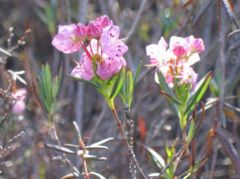Bog-laurel
| Kalmia polifolia subsp. var. | Bog-laurel | |||||||||||||||||||||||||||||||||||||||||||||||||||||||
|---|---|---|---|---|---|---|---|---|---|---|---|---|---|---|---|---|---|---|---|---|---|---|---|---|---|---|---|---|---|---|---|---|---|---|---|---|---|---|---|---|---|---|---|---|---|---|---|---|---|---|---|---|---|---|---|---|

|
|
| ||||||||||||||||||||||||||||||||||||||||||||||||||||||
| ||||||||||||||||||||||||||||||||||||||||||||||||||||||||
Bog-laurel (Kalmia polifolia) is an evergreen shrub of cold acidic bogs, in the family Ericaceae. It is native to north-eastern North America, from Newfoundland to Hudson Bay southwards.
Its leaves are arranged oppositely on the branch. They are waxy with an entire, revolute margin. The base of the petiole is pressed against the stem. Below each leaf base there are ridges, where it appears as though a part of the leaf is curled around the circumference of the stem. This is especially noticeable lower on the plant.
Bog-laurel contains grayanotoxin, which when ingested lowers blood pressure, and may cause respiratory problems, dizziness, vomiting, or diarrhea.[1]
| Standard Cyclopedia of Horticulture |
|---|
|
Kalmia polifolia, Wang. (K. glauca, Ait.). Low, straggling shrub, to 2 ft.: lvs. almost sessile, oval to linear-oblong, obtuse, revolute at the margins, 1/2-1 ½in.- long: fls. in simple terminal umbels, slender-pedicelled, ½-3/4in. across, rose-colored or purplish. May, June. Newfoundland to Pa. and in the rocky mts. from Sitka to Calif. var. microphylla, Rehd. (K. microphylla, Heller), is the alpine form of the rocky mts., growing only a few inches high, and with very small lvs., 1/2in. or less long. var. rosmarinifolia, Rehd. (K. glauca var. rosma- rinifolia, Pursh), has narrow, linear-oblong, strongly revolute lvs.
|
Cultivation
Propagation
Pests and diseases
Varieties
Gallery
-
photo 1
-
photo 2
-
photo 3
References
- ↑ Jim Pojar and Andy MacKinnon, ed (2004) (in English language). Plants of the Pacific Northwest Coast (Revised ed.). Vancouver: Lone Pine Publishing. p. 53. ISBN 978-1-55105-530-5.
- Standard Cyclopedia of Horticulture, by L. H. Bailey, MacMillan Co., 1963
External links
- w:Bog-laurel. Some of the material on this page may be from Wikipedia, under the Creative Commons license.
- Bog-laurel QR Code (Size 50, 100, 200, 500)
